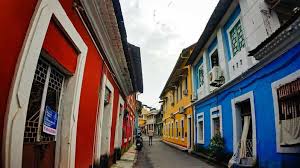
Fontainhas Quarter
UNESCO World Heritage Zone - Latin Quarter of Panaji
Fontainhas, often called the Latin Quarter of Panaji, is a UNESCO World Heritage Zone that represents one of the best-preserved examples of Portuguese colonial residential architecture in India. This charming neighborhood, with its narrow winding streets and colorful houses, offers visitors a glimpse into the daily life of Portuguese Goa.
Named after the Fountain of Phoenix (Fonte Phoenix), the area developed during the 18th and 19th centuries as a residential quarter for Portuguese officials, merchants, and local families. Today, it remains a living heritage site where traditional Goan families continue to reside in ancestral homes, maintaining the authentic character of the neighborhood.
The architecture of Fontainhas represents a unique fusion of Portuguese colonial design adapted to tropical conditions. The houses feature distinctive elements such as red-tiled roofs, colorful facades, ornate balconies, and azulejo tiles, creating a Mediterranean atmosphere in the heart of India.
Distinctive Features
- • Colorful painted facades
- • Red clay tile roofing
- • Ornate wooden balconies
- • Portuguese azulejo tiles
Urban Planning
- • Narrow winding streets
- • Central courtyards
- • Hillside terracing
- • Community spaces
What makes Fontainhas truly special is that it remains a living heritage site. Families who have lived here for generations continue to maintain their ancestral homes, preserving traditional ways of life while adapting to modern needs. The neighborhood comes alive during festivals, particularly during the Feast of St. Sebastian in January.
The area is also home to several important cultural institutions, including art galleries, heritage hotels, and traditional bakeries that have been operating for decades. Walking through Fontainhas offers visitors an authentic experience of Goan-Portuguese culture that has been preserved for over two centuries.
Heritage Recognition
Fontainhas was declared a UNESCO World Heritage Zone, recognizing its outstanding universal value as an example of Portuguese colonial urban planning.
Conservation Guidelines
Strict conservation guidelines were established to preserve the architectural integrity and character of the neighborhood while allowing for necessary modernization.
Ongoing Preservation
Continuous efforts by residents, government agencies, and heritage organizations ensure the preservation of this unique cultural landscape for future generations.
Chapel of St. Sebastian
Built in 1880, this small chapel is the spiritual center of the neighborhood and hosts the annual feast celebration.
Gitanjali Gallery
A heritage house converted into an art gallery showcasing contemporary and traditional Goan art.
Traditional Bakeries
Several century-old bakeries continue to serve traditional Goan bread and pastries using time-honored recipes.
Heritage Homes
Many private residences showcase excellent examples of Portuguese colonial domestic architecture.
Best Time
Early morning (7-9 AM) or late afternoon (4-6 PM)
Duration
2-3 hours for a leisurely exploration
Photography
Respect privacy of residents when photographing